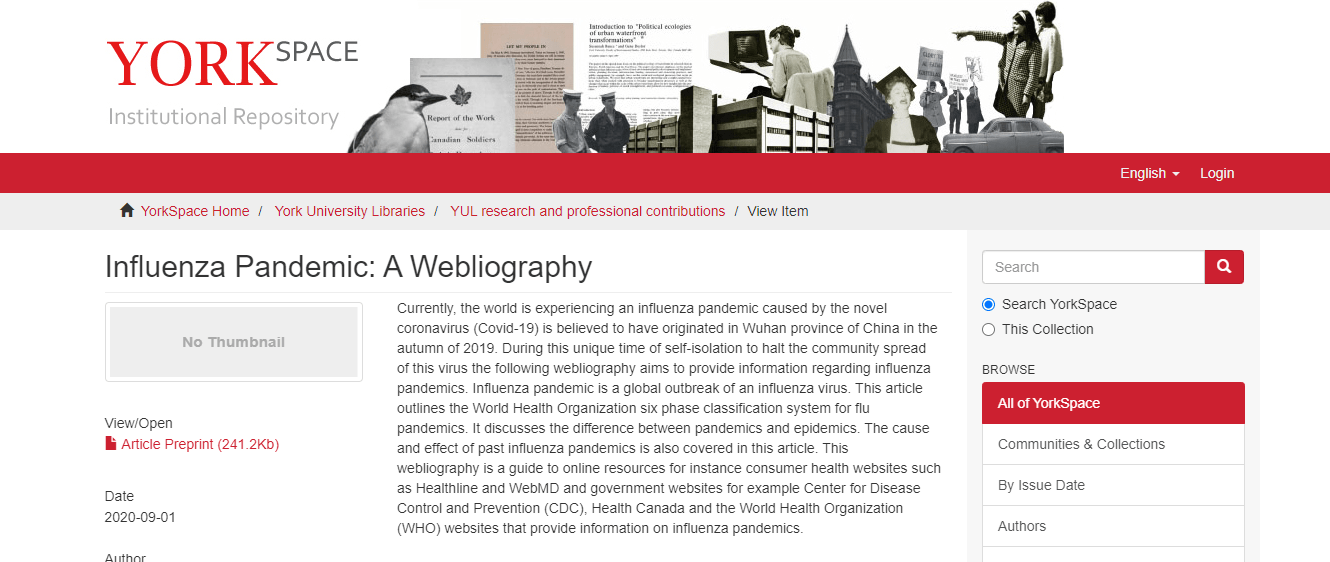After realizing the necessity for key research on influenza-based pandemics to be made available to the public, York librarian Marcia Salmon created a webliography — a list of electronic documents and websites — for reliable sources.
The webliography itself is titled Influenza Pandemic: A Webliography and was published on Journal of Consumer Health on the Internet. It is, as Salmon writes, “a guide to reliable websites that provide information on influenza pandemics.”
In an article by yFile, Salmon explained some of the article’s content: “This webliography provides information on how pandemics occur and are classified; past pandemics; and how to manage, mitigate, and prepare for pandemics now and in the future.”
The sites linked in the webliography talk about a multitude of topics, such as ways that countries are already preparing for the next pandemic so they are better suited for future breakouts.
They also address some common confusions and concerns regarding the pandemic, such as the difference between epidemics and pandemics, as well as providing an overview of some of the high-profile sources she used. These include the Centers for Disease Control and Prevention (CDC), the World Health Organization (WHO), and the Public Health Agency of Canada.
“There was a growing need, in the research community and the public, to better understand influenza pandemics in light of COVID-19,” says Yanni Dagonas, deputy spokesperson for York Media.
One link is dedicated to explain some of the myths about the pandemic, such as, “Can eating garlic help prevent infection with COVID-19” and “Does taking a hot bath prevent COVID-19.”
Salmon herself also provides context of past pandemics. She touches on the past four pandemics of the Spanish flu, H2N2, and H3N2. She also brings up the case numbers of other pandemics — all in the millions — to have a better understanding of how they are comparable to the COVID-19 pandemic.
Even though other pandemics haven’t been on as large a scale as COVID-19 and date from 1918 to 2019, having the resources readily available can allow people to compare those outbreaks to ours. This information could help people today learn how to deal with COVID-19. Being able to use tactics that have been previously successful, and knowing what approaches didn’t work, could allow us to better tackle this pandemic.
Providing context is something that Salmon is skilled at, having worked at the university for 18 years, saying that she is the best person to make this kind of resource. In her work, Salmon specializes in providing electronic sources.
“I researched the topic to find relevant, reliable, and credible sources,” Salmon added.
The importance of easy-access resources, like this webliography, is increasing as cases continue to rise in many countries and as the one year anniversary of the first lockdown in Ontario is approaching. People are ready for the world to return to normal, sick of hearing about the state of the world, and will just about believe anything online.
Luckily, the resource is accessible to everyone and will hopefully clear up some misconceptions.
“Salmon has made the resource available on York Space, meaning members of the public who don’t have Passport York accounts or subscribe to the Journal of Consumer Health on the internet now have access to it,” adds Dagonas.
The webliography can be accessed by the public here.


